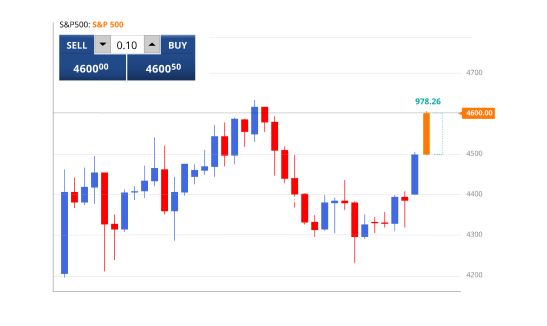交易指數差價合約
來自美國、英國、歐洲、亞洲和澳洲的貿易指數
交易具有風險
指數來自
US, 英國、歐盟與亞洲
來自交易
$0 佣金
高達
1: 100倍槓桿
+
16 指數
指數來自
US, 英國、歐盟與亞洲
來自交易
$0 佣金
高達
1: 100倍槓桿
+
16 指數
交易全球股票市場指數
符號
出價
問
點差

*本頁價格僅供參考。流動性較低的工具,如但不限於外來貨幣對、股票和指數,其價格不像一般交易工具那樣經常更新。請查看您的MT4/MT5平台內的最新即時價格
什麼是指數?
指數代表按行業部門或國家組織的股票集合,並追蹤其整體表現。指數對於監控更廣泛的股票市場的整體表現特別有用。並提供單一的可交易工具來獲得所有指數成分股的投資。

熱門指數包括
S&P 500
Symbol: S&P500
由500家美國大型公司組成的指數,代表美國股市整體狀況。
Dow Jones
Symbol: DJ
該指數追蹤 30 家美國大型上市公司。
Nasdaq
Symbol: NAS
包含在納斯達克證券交易所上市的所有股票的指數。納斯達克指數深受科技板塊的影響。
FTSE 100
Symbol: UK100
代表英國倫敦證券交易所上市的 100 家最大公司的指數。
DAX
Symbol: DE30
在法蘭克福證券交易所上市的德國主要公司的指數。
Euro Stoxx 50
Symbol: STOXX50
來自 12 個歐元區成員國的歐洲領先藍籌公司的指數。
IBEX 35
Symbol: ESP35
西班牙股票市場指數,包含在馬德里證券交易所交易的 35 隻流動性最強的股票。
ASX 200
Symbol: AUS200
澳洲證券交易所上市公司 200 強的基準指數。
Nikkei 225
Symbol: JP225
代表在東京證券交易所上市的 225 家日本大型公司的股票市場指數。
Hang Seng Index
Symbol: HK50
該指數代表在香港證券交易所上市的 50 家規模最大、流動性最強的公司。
指數交易如何運作
指數交易允許您根據一組股票的表現進行交易,而無需購買每家公司的股票。如果您認為該指數的價值可能會上漲,您可以簡單地購買該指數。如果您認為該指數的價值可能會下跌,您可以賣出它。

買入價和賣出價

做多或做空

指數以手數交易

指數交易涉及槓桿和保證金
指數交易範例
您決定使用 100:1 槓桿以 4500 點買入 0.1 手 S&P500。

10 份指數合約 x 4500 = 45,000 美元
USD 45,000
USD 45,000 / 100 = USD 450
現在您已在 S&P500 中開設了價值 45,000 美元的多頭部位。由於指數是使用槓桿進行交易的,因此您的交易帳戶中僅使用了 450 美元作為保證金。一段時間後,標準普爾 500 指數的價格變動,您決定賣出。
場景 1

S&P500 從 4500 點上漲至 4600 點,您決定賣出。
這就是交易利潤或損失的計算方式。
盈虧 = (當前價格 - 初始價格) x 持倉價值) / 當前價格
盈虧= ((4600 - 4500) x 45,000) / 4,600
盈虧 = (100 x 45,000) / 4,600
盈虧 = 978.26
場景 2

S&P500 從 4500 點下跌至 4400 點,您決定賣出。
這就是交易利潤或損失的計算方式。
盈虧 = (當前價格 - 初始價格) x 持倉價值) / 當前價格
盈虧 = ((4400 - 4500) x 45,000) / 4,400
盈虧 = (-100 x 45,000) / 4,600
盈虧 = -978.26
極具價值的交易與優質服務
這就是像您這樣的人選擇TIOmarkets的原因

點差低至0.0 pips
直接由我們的流動性供應商提供raw可變點差交易

零佣金
在我們的VIP Black或Standard交易帳戶上,從$0每手開始交易

低起點金額
只需$20即可開戶開始交易

快速訂單執行
交易在毫秒內執行,大部分時間滑點低

不限leverage。
透過使用不限leverage進行交易,發揮最大潛力

30%忠誠獎勵
在我們的Standard帳戶每次存款均可獲得獎金
在 MT4 交易平台上進行交易
可透過桌上型電腦、瀏覽器或行動裝置進行

快速簡單上手
只需要幾分鐘,它是這樣工作的

步驟 1
註冊
完善您的個人資料並創建帳戶

步驟 2
基金
通過我們便捷的融資方式即時存款

步驟 3
貿易
下載交易平台並登入開始交易
交易具有風險




